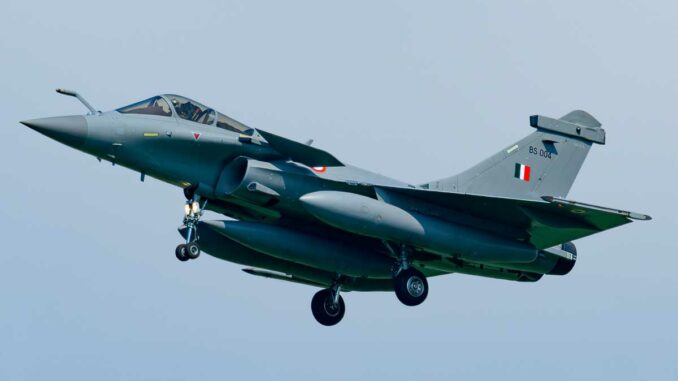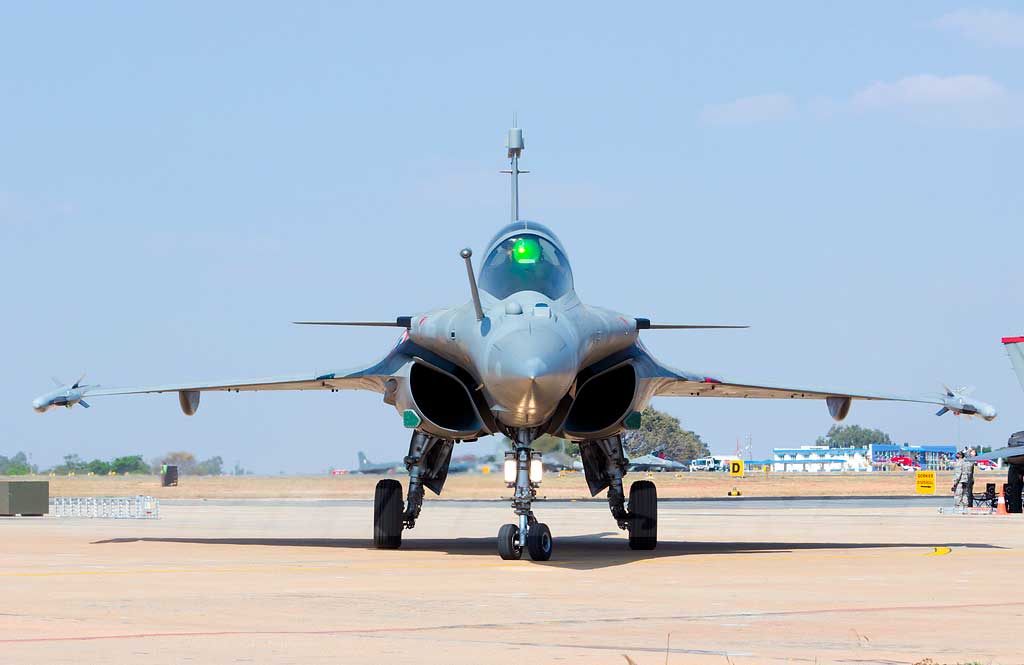
The eight-year delay in the delivery of GaN radars for Indian Rafale fighter jets is worrying New Delhi, given the threat posed by China’s J-20 fighter jets. Dassault and Thales are under pressure.
Technological vulnerability in the face of Chinese ambitions
The Indian Air Force (IAF) is facing a major strategic alert. An eight-year delay in upgrading gallium nitride (GaN)-based radars for its Rafale fighter jets could create an operational gap that will be difficult to compensate for, particularly against Chinese aircraft equipped with the Chengdu J-20. The report, published on June 30, 2025, highlights that the technological gap has widened since 2017, the date initially envisaged for the transition to RBE2 AESA-GaN radar by French manufacturers.
The GaN technology, developed by Thales, offers increased detection power, better resistance to electronic warfare, and a compact format that improves heat dissipation. However, the 36 Rafale aircraft delivered to India since 2020 are still equipped with RBE2-AESA radars based on gallium arsenide (GaAs), which are less powerful in terms of peak power and multi-target management.
India, which is engaged in a strategic confrontation with China on the eastern Himalayan border, now considers the French delay to be a critical failure in its modernization plan. Pressure is mounting on Dassault Aviation and Thales, two industrial players that are struggling to prioritize export versions of the GaN radar, even though the F4.2 standard for the Rafale in France has included this technology since 2024.

A worrying technological gap in a high-intensity environment
The RBE2-AESA GaN radar, planned for the F4.2 and F5 upgrades of the Rafale, offers significant advantages over the current GaAs version. By using gallium nitride transistors, it doubles the power output for the same dimensions, while increasing the pulse density per surface area. This improvement translates into an estimated 20-30% increase in effective range, an increased ability to process multiple tracks simultaneously, and better immunity to jamming and active decoys.
By comparison, according to several Western sources, the Chinese J-20 is now equipped with an AESA radar based on the Type 1475 GaN radar, with a range of over 300 kilometers and capable of tracking around 20 targets simultaneously. At this stage, the Indian Rafale can only effectively engage an aircraft such as the J-20 in an optimized environment (AWACS cooperation, prior identification, etc.). In BVR (Beyond Visual Range) combat, the advantage clearly lies with Beijing.
The J-20 also has advanced onboard electronic warfare systems, remote jamming pods, and optimized frontal stealth. The Rafale’s superiority, which until now has been ensured by its maneuverability, Meteor missiles, and SPECTRA suite, becomes partial without a radar capable of fully exploiting the long-range environment.
However, testing of the RBE2-GaN began in 2014. But Thales, faced with industrial limitations, prioritized the modernization of French aircraft and will not deliver operational GaN modules for export before 2024. This decision, dictated by production rates, certification requirements, and budgetary constraints, has penalized India despite its initial investment of $7.8 billion in the Rafale program.
Industrial dependence undermines India’s air sovereignty
This delay illustrates the limitations of a turnkey purchasing model, where critical systems remain under the control of the original suppliers. India, which had demanded greater technology transfer, did not obtain the rights to manufacture or integrate the GaN radar. The contract signed in 2016 provides for the delivery of the Rafale in an F3R version, with no binding commitment on future upgrades.
This creates strategic dependence on French industrial schedules. The Indian Rafale program does not have a local retrofit line, and upgrades must go through Mérignac and Limours, where Thales assembles the radar modules. This logistics setup slows down maintenance cycles and prevents any rapid ramp-up, as required by tensions with China and Pakistan.
The local alternative via Bharat Electronics Ltd. or DRDO is not yet mature in the AESA-GaN segment. India has invested in the Uttam AESA radar for the Tejas Mk2, but it has not yet reached the performance thresholds required for Rafale-class fighter jets. The French delay is therefore having an impact on India’s entire airspace control strategy.
Faced with this situation, voices are being raised within the IAF command to redirect certain future orders to platforms with native GaN radars. The Su-57, offered by Russia with an N036 Byelka radar, and the American F-15EX are being mentioned as complementary alternatives, although no agreement has been formalized at this stage.

A delicate crisis management situation for French manufacturers
On the French side, the situation is being monitored with caution. Dassault Aviation, which is leading the Rafale platform, remains dependent on Thales for radar equipment. Thales, which is involved in the Rafale F5 program, has already delivered the first GaN modules for French aircraft, but export expansion remains marginal. By 2025, only four to six GaN radars are expected to have been delivered outside France, all for test programs or pilot units.
The problem is therefore both industrial and political. GaN transistor production capacity in Europe remains limited. The only certified production line for the military aviation sector is located in Limoges. It can only produce a few dozen modules per year, which is well below the global retrofitting needs of the Rafale fleet.
The pressure exerted by India highlights a strategic sticking point: the gap between modernization announcements and the actual ability to deliver them. For New Delhi, this delay is more than a technical incident. It calls into question confidence in the Rafale’s technological promise as a regional superiority fighter jet.
The French Ministry of the Armed Forces has not officially commented on the situation, but discussions are reportedly taking place behind the scenes to propose an acceleration plan. This would include the availability of GaN radars from late 2026, with initial operational integration in 2027. This delay is considered too late by some members of the Indian military leadership, who anticipate a peak in Sino-Indian tensions in the next two to three years.
War Wings Daily is an independant magazine.